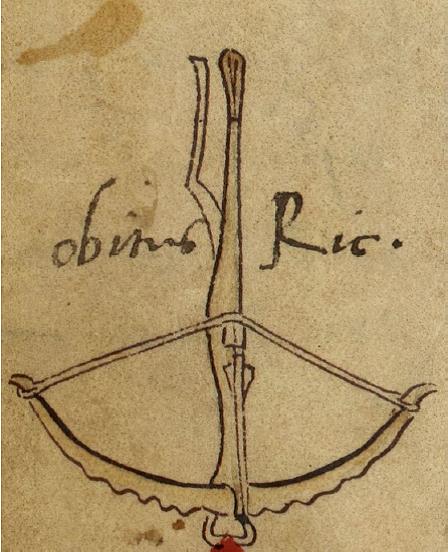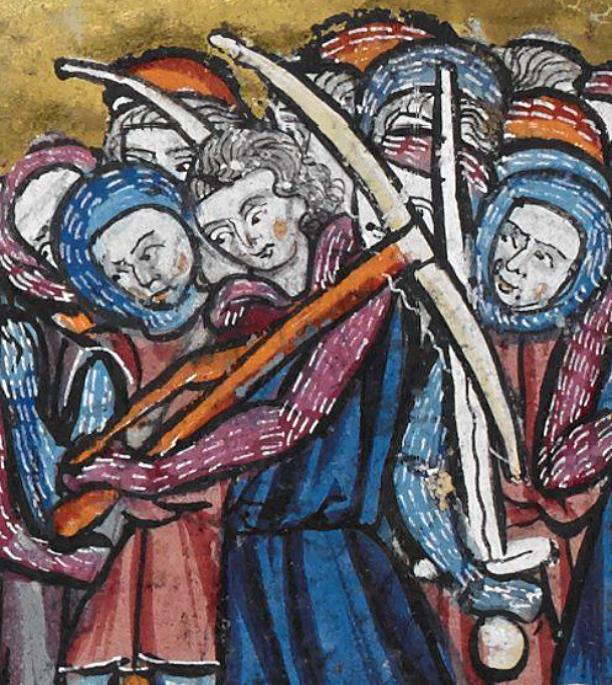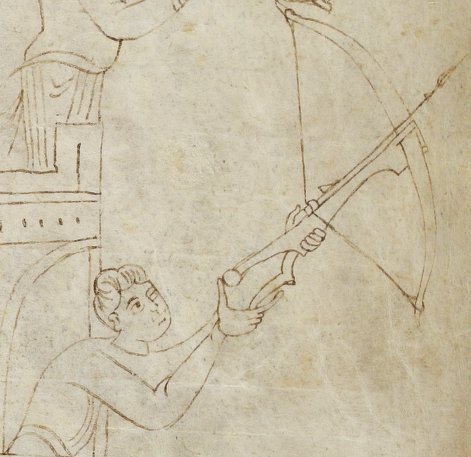| Author |
Message |
|
William P
|
 Posted: Mon 17 Feb, 2014 2:32 am Post subject: asking for advice on XII-XIII era crossbows/men Posted: Mon 17 Feb, 2014 2:32 am Post subject: asking for advice on XII-XIII era crossbows/men |
 |
|
Hi there guys,
my question is that i have recently joined a group which wants to be all about the common soldier (called, amusingly, the revolting peasants), it's a newly formed group tha reenacts the commoners lifestyles, so you wouldnt see guys in lots of maile and knightly dress in this group etc.
i think we mostly plan on
ou schosen focus is mostly the countries of England and France between 1100 and 1250.
I realised that this time period includes the 3rd crusade, and that the crossbow was becoming more and more readily improved and widely adopted.
so, i'd like to ask a few questions
What forms did crossbows take during that period, how did they look at the start through what stages did they progress through up to arond 1250.
in particular i wonderabout the crossbows used during the time of the 3rd crsade i.e the last quarterof the 12th century and the very beginning of the 13th century (3rd crusade was 1189-1192)
adding to that, what sort of loading mechanisms and poundages were in use around the latter quarter of the 12th century
lastly is a bit more tricky,
how accesible was the crossbow around that time, i know pope innocent in year 1138 made that decree banning the crossbbow usage by christians against christians.
also is the question of wealth and access by 'common soldiery; who could and couldnt be able to get their hands on it, etc
better question what kind of men made up the ranks of the crossbowmen in latin crusader armies? actual commoners or much better paid men?
MY assumption is that a crusader era crossbow would have been mostly a composite crossbow, using something like a belt and claw or being hand spanned or, at most using a cranequin. poundages would have been, at most 800lb's
Leo from tods stuff i know does a LOT of work with crossbows so I'd be keen to hear his thoughts on what type of crossbow was used when etc.
i also know crossbow levies were quite common in eastern europe and russia, how common were they in western europe?
i know that the famous armies of longbowman that made england famous in the hndred years war i dont think had its makings ntil the end of the 13th century with the laws being passed to encourage bow usage occuring in the 14th century. IIRC
but im open to being completely wrong about all of these things.
|
|
   |
 |
|
Mart Shearer
|
 Posted: Mon 17 Feb, 2014 3:49 am Post subject: Posted: Mon 17 Feb, 2014 3:49 am Post subject: |
 |
|
Lots of questions, so I'll try to fill in a small piece.
Perhaps the closest miniature from the time of the 3rd Crusade:
http://manuscriptminiatures.com/3966/11574/
From the Historia Anglorum of Matthew Paris, Royal MS 14 C VII, fo. 85 verso, dated to the end of your period of study, 1250-1259. I think it's fair to say this stave is knotty wood rather than composite. It's reminiscent of this famous image of a Welsh archer.

http://www.bl.uk/manuscripts/Viewer.aspx?ref=..._vii_f085v
 Attachment: 46.7 KB Attachment: 46.7 KB

ferrum ferro acuitur et homo exacuit faciem amici sui
|
|
  |
 |
|
Mart Shearer
|
 Posted: Mon 17 Feb, 2014 3:53 am Post subject: Posted: Mon 17 Feb, 2014 3:53 am Post subject: |
 |
|
Here's the link at Manuscript Miniatures for 1100-1250 with the tag "crossbow".
http://manuscriptminiatures.com/search/?year=...anuscript=
You should note that most of the people wielding crossbows are mail-armed troops.
ferrum ferro acuitur et homo exacuit faciem amici sui
|
|
  |
 |
Craig Peters

|
 Posted: Mon 17 Feb, 2014 4:05 am Post subject: Posted: Mon 17 Feb, 2014 4:05 am Post subject: |
 |
|
Here's an image of a crossbowman from the Liber ad Honorem Augusti, circa 1197 AD. It is unlikely that the crossbow had changed in any meaningful way since the Third Crusade. You also have the benefit of the fact that he is clearly a common soldier, and does not appear to be dressed in mail.
 Attachment: 24.86 KB Attachment: 24.86 KB

|
|
  |
 |
|
Mart Shearer
|
 Posted: Mon 17 Feb, 2014 10:17 am Post subject: Posted: Mon 17 Feb, 2014 10:17 am Post subject: |
 |
|
It should be noted that in the Liber ad honorem Augusti images, (both on Manuscript Miniatures), that the crossbowmen have helmets while archers do not. This indicates a slightly higher wealth and equipment level for the crossbowmen -- perhaps because they were urban? After 1200, all of the images are showing mail-armed men. Here's an image from a French Bible moralisée, Harley MS 1526, fo. 12v, 6th roundel, dated from 1226-1250.
 Attachment: 107.49 KB Attachment: 107.49 KB

ferrum ferro acuitur et homo exacuit faciem amici sui
|
|
  |
 |
Bartek Strojek

|
 Posted: Mon 17 Feb, 2014 10:17 am Post subject: Posted: Mon 17 Feb, 2014 10:17 am Post subject: |
 |
|
| Quote: | | at most using a cranequin |
I'm not really good person to quote here, but I'm pretty sure that no such things as cranequin had appeared before at least ~ early 15th century.
The whole 'papal ban' is rather dubious thing, AFAIR, it's not clear how it was stated exactly.
But anyway, needles to say, pope or clergy had no real power to seriously enforce something like that.
http://www.historiavivens1300.at/hv1300.htm
This site has some info and reconstructions of early crossbows (in German).
[/code]
|
|
  |
 |
Jonathan Blair

|
 Posted: Mon 17 Feb, 2014 12:20 pm Post subject: Re: asking for advice on XII-XIII era crossbows/men Posted: Mon 17 Feb, 2014 12:20 pm Post subject: Re: asking for advice on XII-XIII era crossbows/men |
 |
|
| William P wrote: | Hi there guys,
my question is that i have recently joined a group which wants to be all about the common soldier (called, amusingly, the revolting peasants), it's a newly formed group tha reenacts the commoners lifestyles, so you wouldnt see guys in lots of maile and knightly dress in this group etc.
ou schosen [SIC] focus is mostly the countries of England and France between 1100 and 1250. |
In a slight and momentary derailment of the thread...
Just because a person was a commoner didn't mean they weren't "of means". There were rich and poor commoners and rich and poor gentry. A franklin or a yeoman (a late medieval term for a similar class of English commoner) could own his own land as a free man (40 shillings annual income), and would rent some of that land out to other commoners. As a result, his income could rival that of lower landed gentry. He often couldn't afford a household of servants or be able to equip any retainers for war (or didn't want to), but some could afford armor and weapons as good as some knights and esquires, although they were not entitled to heraldry. He often served as a constable, sheriff, or mayor, or act as a sargeant or valet of a knight or esquire.
Now back to the previously scheduled discussion, already in progress.
"Think not that I am come to send peace on earth: I came not to send peace, but a sword." - The Lord Jesus Christ, from The Gospel According to Saint Matthew, chapter x, verse 34, Authorized Version of 1611
|
|
  |
 |
|
Mart Shearer
|
 Posted: Mon 17 Feb, 2014 1:22 pm Post subject: Posted: Mon 17 Feb, 2014 1:22 pm Post subject: |
 |
|
Crossbows aren't mentioned in the English Assize of Arms of 1181, and the Assize of 1242 mentions bows for those whose annual worth is under £2. Crossbows aren't specifically mentioned until the Arrays of 1276/1277 when they are assigned for those with £5, and bows for those with a worth under £2.
It seems to me that the only spanning mechanism which comes into play during this period is the foot stirrup. There has been some debate over the difference between "one foot" and "two foot" crossbows. Some argue that the one foot design used a stirrup and the two foot designs were cocked with one foot on either side of the tiller and both on the bow. Thom Richardson has argued the distinction is in the length of the bolts. I'll review the images to see how early a belt hook can be found for aid in spanning.
The earliest I've found so far is in the Maciejowski Bible: 1245-1255 the fellow at the lower right.
http://manuscriptminiatures.com/4673/8016/
But later in the century we see some men using the belt hook while others still rely on their hands.
http://manuscriptminiatures.com/3971/10443/
http://manuscriptminiatures.com/4724/12498/
ferrum ferro acuitur et homo exacuit faciem amici sui
|
|
  |
 |
|
Pieter B.
|
 Posted: Mon 17 Feb, 2014 1:55 pm Post subject: Re: asking for advice on XII-XIII era crossbows/men Posted: Mon 17 Feb, 2014 1:55 pm Post subject: Re: asking for advice on XII-XIII era crossbows/men |
 |
|
| William P wrote: |
i also know crossbow levies were quite common in eastern europe and russia, how common were they in western europe?
i know that the famous armies of longbowman that made england famous in the hndred years war i dont think had its makings ntil the end of the 13th century with the laws being passed to encourage bow usage occuring in the 14th century. IIRC
but im open to being completely wrong about all of these things. |
Well regarding levies in England and France.
I believe we can safely say that the French military leadership held feudal levies in low regard. Even more so before the battle of Courtrai 1302. The French nobility did however acknowledge the power of a crossbow as they did bring them along on the crusades and used them against the English in the much later Hundred Years War. But seeing how feudal levies from rural areas probably didn't have crossbows lying around I don't think a lot of levies used crossbows. I could hardly imagine the nobility handing crossbows out to levies.
I would say that the "common" folks who used a crossbow were limited to urban militias and mercenaries. We have plenty of evidence that Mercenaries and to some degree urban militias used crossbows from 1300 onward. The fact that later crossbowmen are depicted as wearing mail armor backs the theory that they had to be at least of some standing or wealth and indicates that they were professionals.
|
|
  |
 |
Leo Todeschini
Industry Professional

|
 Posted: Mon 17 Feb, 2014 2:29 pm Post subject: Posted: Mon 17 Feb, 2014 2:29 pm Post subject: |
 |
|
Hi Wiliam,
I am not sure I can throw that much light on the subject for you.
Crossbows with rotating nut triggers that were current through until at least the 16thC, may have started in late Roman times and so for those with little money these are likely to have stayed pretty much the same.
There is a bone nut from a 5thC find in Scotland (though I personally am not sure it is quite what it appears to be) so we can presumably date them from here on.
Early crossbows were of wood and that seems to be the case through to the 14thC when composites started to be used in Western Europe, though what was actually used in the Crusades I don't know. Partly because one assumes that longstanding enemies often adopt and adapt the good parts of the others weaponry and the Saracens used composites for their bows and indeed composites seem to work very well in hot climes.
Around 1400 steel started to be used for bows and composite started to drop out of favour for military bows but remained for hunting bows.
The stirrup appears to not be universal in the early part of this millennia and the bow was often mounted right at the front of the stock or through a hole and then lashed in place, but the bow was loaded by placing a foot either side of the tiller and drawing back. Some time in the 12th or 13thC stirrups arrived and so protected the bow.
Loading systems like belt and claw preceeded more mechanical means and were in use by the end of your period, but I am not sure at the start. Goats foot, windlass etc are out of the question.
If a client asked me, I would make a bow with a very boring straight tiller, antler nut, straight steel trigger, and wooden bow that can be spanned by hand - around 180 to 200lb would be fine. A belt and claw could be used to up this to 260lb
I hope this helps.
Tod
www.todsworkshop.com
www.todcutler.com
www.instagram.com/todsworkshop
https://www.facebook.com/TodsWorkshop
www.youtube.com/user/todsstuff1
|
|
   |
 |
|
Mart Shearer
|
 Posted: Mon 17 Feb, 2014 4:59 pm Post subject: Posted: Mon 17 Feb, 2014 4:59 pm Post subject: |
 |
|
An example from the Roda Bible, BNF Latin 6 (3) fo. 144v, 1075-1100. This might be the exemplar for a bow from the beginning of you period.
 Attachment: 42.23 KB Attachment: 42.23 KB

ferrum ferro acuitur et homo exacuit faciem amici sui
|
|
  |
 |
|
|
You cannot post new topics in this forum
You cannot reply to topics in this forum
You cannot edit your posts in this forum
You cannot delete your posts in this forum
You cannot vote in polls in this forum
You cannot attach files in this forum
You can download files in this forum
|
All contents © Copyright 2003-2025 myArmoury.com — All rights reserved
Discussion forums powered by phpBB © The phpBB Group
Switch to the Basic Low-bandwidth Version of the forum
|

